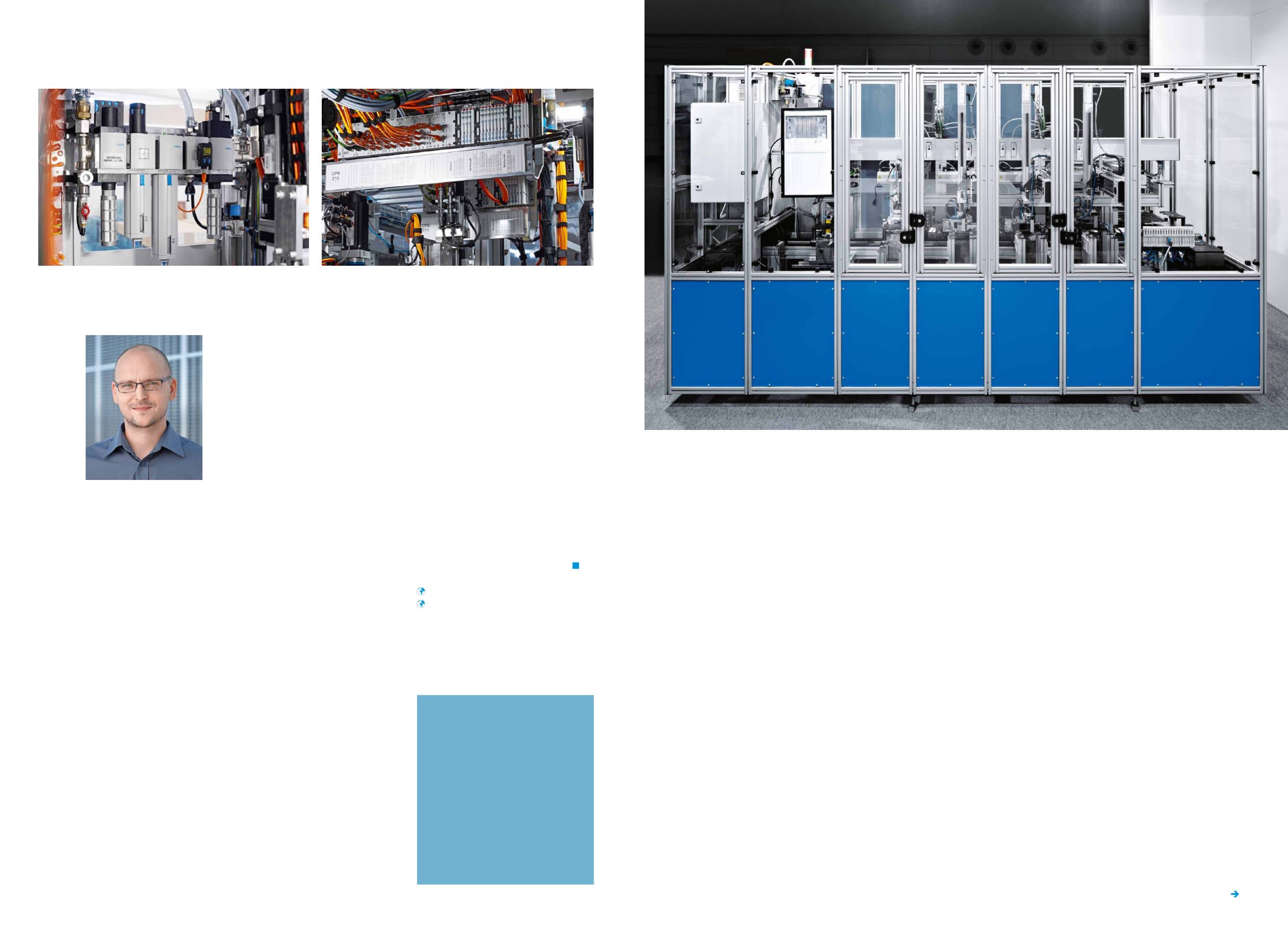
Settingnewstandards:
TheserviceunitMS9-SV-C combines the
build-upof compressedairwithexhaust inone component.
Reliableandprecise control:
Oneofmanyvalve terminalsCPX
ensuresseamlessprocesses.
enoughof thisefficient energysource
available for the complex system inevery
loadsituation requiresadelicatebalance
between control andmaintenance. Large
partsof thesystemarecontrolledbyFesto
valve terminalsCPXwithwide-ranging
specifications. TwoserviceunitsMS9-SV-C
ensure that the compressedair quality
remains constant. The term“serviceunit”
onlypartlydescribeswhat theMS9-SV-C
can reallydo.Of course it hasall the
compressedair preparation functions–
includingpressure regulators, on-off and
soft-start valves, filters, dryers, sensors
and lubricators–which canbe combined
tosuit theapplication.However,what
sets theMS9-SV-Capart fromother service
units is the combinationof apressure
build-up functionwithanon-off andex-
haust valveso that devices canbe fully
exhaustedand there isno residual
pressure.Having two functions inasingle
housingnot onlysavesspace, but also
ensuresgreater operator safetyduring
commissioningandmaintenanceandpro-
tects central pneumatic components, axes
andshockabsorbers. In thenewsystem
fromStiwa, 4bar isfirst built upand then
STIWAHolding
GmbH
Salzburger Straße52
4800Attnang-Puchheim
Austria
Areaof business:
High-performanceautomation,
product andsoftwaredevelopment
formanufacturingautomation
switched through foraworkingpressureof
5.3 to7bar as compressedair is required.
Increasedflow rate
Stiwauses twoserviceunitsMS9-SV-C in
itsnewsystem, as it requiresa lot of com-
pressedair duringstart-up. Compared
with theserviceunitsused in theprevious
models, thenewsystem fromStiwahas
1,000 l/minmorecompressedairavailable
thanks to theMS9-SV-C. The largenominal
flow rateof up to16,000 l/min (up to
5,000 l/min in theStiwasystem)means
that the companymayevenbeable to
saveononeserviceunit for especially
largemachines.
Newstandardset
Stiwawas thepilot partner of Festo for
field testing theMS9-SV-C. Thehigh-tech
Austrian company is itself a leader in the
development of innovativeautomation
systems. TheMS9-SV-Cwasfine-tuned
during intensivefinal testsandgivenan
earlyentry intoproduction–evenbefore
itsofficialmarket launch. It is thuswell
prepared for theworldof industrial produc-
tion,where it candeliver greater security
andperformanceaswell as reducedcosts.
TheAustrianmachinebuildersnowuse
theMS9andMS9-SV-Casstandard.
“With theMS9-SV-Cwehave
aserviceunit that suitsour
demandingsystemsperfectly.”
StefanBaier,Headof ProductManagement Electrical EngineeringandPneumatics, Stiwa
Power out of thebox
Quality testingof bipolar plates for fuel cells
Fuel cellsoffergreat hope
for sustainablepower generation. Theyhavean
extremelywide rangeof applications. Inanewsystem for thequalityassurance
of bipolar plates, electric cylindersEPCOhelp toprevent vibration toallow
continuous testingwithshort cycle times.
H
ighefficiency, lowemissionsand
nomechanicalwear – fuel cells
offermanyadvantagesas
sustainablesuppliersof energy.
Theyaresuitable for thepropulsionof
vehicles, for supplyingpower tomobile
devices, asefficient performers instation-
arypower plantsandmuchmore. Among
their key componentsarebipolar plates.
Theelectrodeplatesaremade frommetal,
plasticor carbonnanotubesandare coat-
edwitha catalyst suchasplatinumor
palladium. Theyseparate reactant gases
and coolingmedia fromoneanother and
distribute them to the respective reaction
zonesof the fuel cells. Toensuregood
electrical and thermal conductivityaswell
as resistance to chemicalsandhighmech
anical contact pressure, bipolar plates
must beof averyhighquality. Anew
testing facility fromP+KMaschinen- und
AnlagenbauGmbH checks thesurface
finishof bipolarplatesandmeasures their
thickness. Electric cylindersEPCOwith
steppermotor EMMS-STandmotor
controllerCMMO-ST fromFestoensure the
vibration-free transport of bipolar plates
in the testing facility.
Contactlesshandling
The innovative testing facility fromP+K is
beingused for researchpurposesand the
development of new fuel cell production
technologies forTier 1suppliers. The test
process takesplaceat a total of 12 indi-
vidual stations. Electric cylindersEPCO
ensure low-vibration transport at and
between thesestations.At thefirst station,
aBernoulli gripper picksup thebipolar
plates froma conveyor andplaces them
onaworkpiece carrier. Toplace the
electrodeplateson this carrier, a corner
isopenedpneumatically, thebipolar plate
isplaced in the carrier and the carrier is
then closedpneumaticallybymeansof a
springmechanism.
Gentlydoes it
Next comes thevisual inspectionof the
coolingsideof thebipolar plateusinga
high-performance industrial camera.
Quality forhighefficiency:
Thenewsystem fromP+K checks the thicknessandsurfacefinishof bipolar plates.
1.2014
trends inautomation
Synergies
36
–
37


